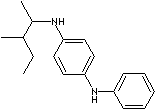PRODUCT IDENTIFICATION
793-24-8

Oral rat LD50: 3580 mg/kg
N-(1,3-Dimethylbutyl)-N´-phenyl-1,4-benzenediamine; Antioxidant CD; 6PPD; N-(1,3-Dimethylbutyl)-N'-phenyl-p-phenylenediamine; N-1,3-Dimethylbutyl-N'-phenyl-p-phenylendiamine; N-Phenyl-N'-(1,3-dimethyl butyl)-para-phenylenediamine; N-Phenyl-N'-(1,3-dimethylbutyl)-p-phenylenediamine;
CLASSIFICATION
Antiozonant. Antioxidant
EXTRA NOTES
Other RN: 50809-58-0, 76600-84-5
PHYSICAL AND CHEMICAL PROPERTIES
Health:1 Flammability: 1 Reactivity: 0
REFRACTIVE INDEX
204 C
EXTERNAL LINKS & GENERAL DESCRIPTION
USA.gov - 6PPD
Google Scholar Search - 6PPD
PubChem Compound Summary - 6PPD
NCBI (http://www.ncbi.nlm.nih.gov/) - 6PPD
Hazardous Substances Data Bank - 6PPD
EPA - Substance Registry Services - 6PPD
Local:
6PPD is used as an antioxidant and an antiozonant for natural and synthetic elastomers, as a stabilizer of polymers and as a monomer polymerization inhibitor.6PPD is not regulated for use in food contact applications. 6PPD imparts high temperature stability, high strength, and chemical and electrical resistance.
p-Phenylenediamine is used as a parent compound in vulcanization accelerators and in antioxidants for rubber industry. PPD is chosen because it imparts high temperature stability, high strength, and chemical and electrical resistance. Examples of the most widely used anitioxidants or antiozonants derived form p-phenylenediamine are N-isopropyl-N'-phenyl-p- phenylenediamine (IPPD, CAS # 101-72-4) , N-cyclohexyl-N'-phenyl-p- phenylenediamine (CPPD, CAS #: 101-87-1), N,N'-Diphenyl-p-henylenediamine (DPPD, CAS # 74-31-7), and N-(1,3-dimethylbutyl)-N'-phenyl-p-phenylenediamine (6PPD, CAS #: 793-24-8). These derivatives are added to rubber products to retard degradation by oxidants and ozone.
APPEARANCE
44 C
HEAT LOSS
0.5% max
ASH CONTENT
0.3% max
Not Regulated
PRICE
INFORMATION